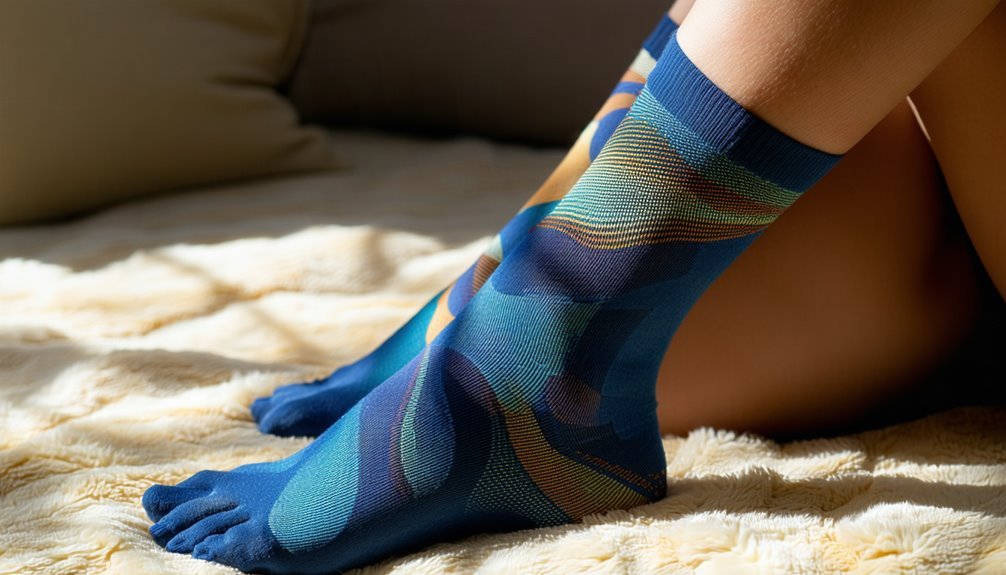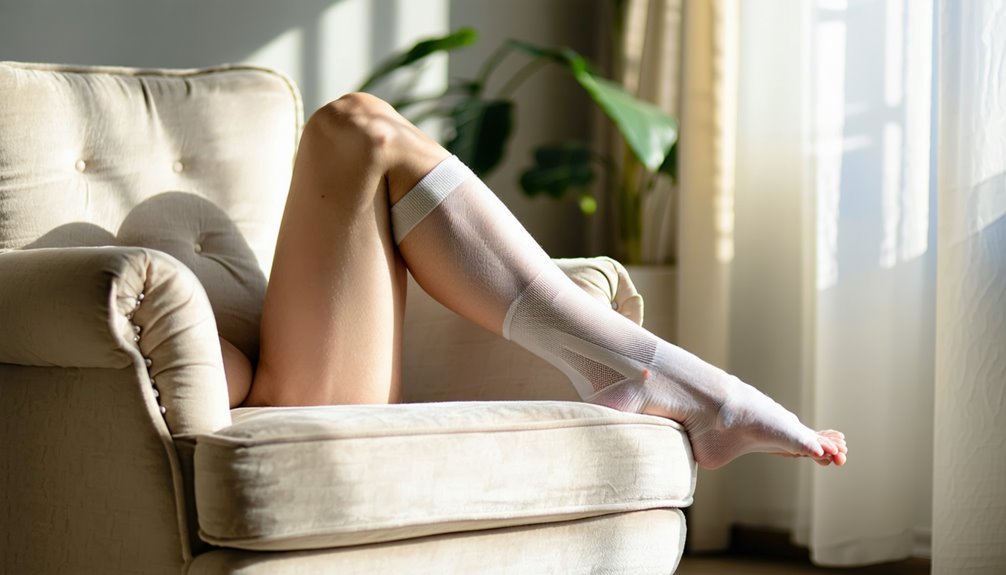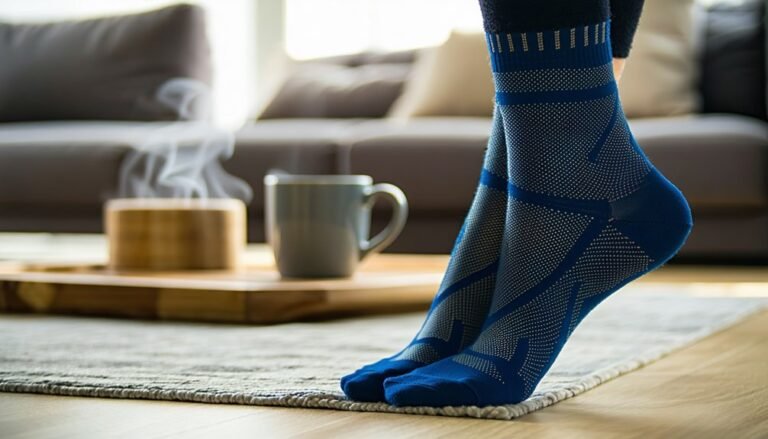Can Compression Socks Help With Restless Legs?
Compression socks may help with Restless Legs Syndrome (RLS) by enhancing venous return and improving blood circulation, potentially reducing discomfort. Studies suggest they could alleviate symptoms, though small sample sizes limit robust conclusions. To effectively incorporate them, consult healthcare professionals to determine the appropriate compression level, typically moderate (15-20 mmHg). Proper fit is essential to guarantee therapeutic efficacy without compromising circulation. With these considerations, you might discover more insights into managing RLS symptoms.
Understanding Restless Legs Syndrome

Restless Legs Syndrome (RLS), although often misunderstood, is a neurological disorder characterized by an uncontrollable urge to move the legs, typically due to uncomfortable sensations. This condition often emerges during periods of rest, particularly in the evening or at night, disrupting your sleep and daily activities. The causes of RLS are multifaceted and can include genetic factors, iron deficiency, and dysfunction in brain pathways involving dopamine. Common symptoms of RLS include tingling, itching, or a creeping sensation in the legs, leading to persistent restlessness. These symptoms may vary in intensity and can greatly impair your quality of life. Recognizing these symptoms early is essential for effective management. Understanding the underlying causes aids in developing preventative strategies, ensuring your safety and well-being.
Common Treatments for RLS
When addressing Restless Legs Syndrome, you should consider a multifaceted approach comprising pharmacological interventions, such as dopamine agonists and gabapentinoids, which have demonstrated clinical efficacy. Additionally, iron supplementation may be beneficial in cases of documented deficiency, while lifestyle modifications, including regular exercise and sleep hygiene, are essential supportive measures. Finally, alternative therapies like pneumatic compression devices and acupuncture might offer adjunctive benefits, though more robust evidence is needed to substantiate their efficacy.
Medications and Supplements
Though restless legs syndrome (RLS) can be challenging to manage, understanding the role of medications and supplements is vital for effective treatment. Medication options like dopamine agonists, such as pramipexole and ropinirole, are often prescribed to alleviate symptoms by targeting neurological pathways involved in movement regulation. Additionally, gabapentin enacarbil may be utilized to modulate nerve impulses. For those seeking natural supplements, consider iron, magnesium, and folate, which have shown potential in addressing nutrient deficiencies linked to RLS. Always consult with a healthcare provider to verify these treatments are safe and suitable for you. It's important to balance efficacy with safety, as some medications may have side effects that require careful monitoring under professional guidance.
Lifestyle and Behavioral Changes
While medications can play an essential role in managing restless legs syndrome, incorporating lifestyle and behavioral changes can greatly enhance treatment outcomes. Adopting evidence-based lifestyle modifications and behavioral strategies can considerably reduce symptoms. For ideal results, consider the following:
- Regular Physical Activity: Engaging in moderate exercise can alleviate symptoms by increasing circulation and reducing leg discomfort.
- Sleep Hygiene: Maintain a consistent sleep schedule to enhance sleep quality, which is vital in managing RLS.
- Dietary Adjustments: Avoiding caffeine and alcohol can decrease symptom severity, as these substances may exacerbate restlessness.
Alternative Therapies Options
In addition to lifestyle and behavioral changes, alternative therapies can offer valuable support in managing restless legs syndrome (RLS). Acupuncture therapy, a cornerstone of traditional Chinese medicine, has shown promise in alleviating RLS symptoms by stimulating specific points to enhance circulation and reduce discomfort. Clinical studies suggest that regular sessions may lead to a reduction in symptom severity, offering a safe, non-pharmacological option. Yoga practices, incorporating gentle stretching and relaxation techniques, also provide therapeutic benefits. By promoting improved sleep quality and reducing muscle tension, yoga can be an effective adjunctive treatment for RLS. These therapies prioritize safety and holistic well-being, aligning with clinical guidelines that emphasize thorough management strategies for RLS, focusing on symptom relief and patient quality of life.
The Role of Compression Socks in Circulation
Compression socks play an essential role in enhancing circulation, particularly for individuals experiencing venous insufficiency or those who stand for extended periods. By exerting graduated pressure on the legs, these socks promote circulation improvement, ensuring ideal blood flow back to the heart. This mechanism reduces venous pooling and mitigates risks associated with impaired blood return.
Key benefits of compression socks include:
- Enhanced venous blood flow: Facilitates the upward movement of blood, preventing stagnation in the lower extremities.
- Reduced edema: Decreases fluid accumulation in tissues, thereby reducing swelling and associated discomfort.
- Minimized risk of deep vein thrombosis: Lowers the likelihood of clot formation by maintaining effective circulation.
For those prioritizing safety, wearing compression socks can be a preventive strategy against circulatory complications.
How Compression Socks May Relieve RLS Symptoms

You'll find that compression socks may alleviate symptoms of Restless Legs Syndrome (RLS) by enhancing venous return, which improves blood circulation in the lower extremities. This enhanced circulation can effectively reduce leg discomfort, a common complaint among individuals with RLS. By applying graduated pressure, these socks facilitate ideal blood flow, potentially mitigating the severity of RLS symptoms.
Improved Blood Circulation
Although often overlooked, proper blood circulation is essential in managing Restless Legs Syndrome (RLS) symptoms. Compression socks can enhance blood flow, promoting improved circulatory health. By applying consistent pressure to the legs, these socks help the veins return blood to the heart more efficiently. This mechanism potentially alleviates RLS symptoms through:
- Enhanced venous return: Pressure from the socks aids in moving blood upwards, reducing pooling in the legs.
- Reduced venous pressure: Lower pressure in the veins can minimize leg swelling, thereby stabilizing blood flow.
- Promotion of vascular health: Consistent use may support overall circulatory health, mitigating RLS symptoms.
Incorporating compression socks into your regimen could be a clinically sound approach to enhance blood circulation, thereby providing a safer daily management strategy for RLS.
Reduced Leg Discomfort
Many individuals with Restless Legs Syndrome experience significant leg discomfort, which can be mitigated by the use of compression socks. These specialized socks apply gentle pressure, enhancing venous return and promoting ideal blood flow. As circulation improves, leg comfort may increase, providing a potential therapeutic benefit for those suffering from RLS symptoms. The compression gradient is vital, ensuring that pressure decreases from the ankle upwards, effectively aiding in fluid redistribution and reducing edema. This mechanistic action not only alleviates discomfort but also contributes to a safer, more restful night's sleep. Evidence suggests that by improving circulation, compression socks can play a significant role in reducing the frequency and intensity of RLS episodes, supporting overall leg health and enhancing patient safety.
Research and Studies on Compression Socks for RLS

Emerging research on compression socks for Restless Legs Syndrome (RLS) suggests potential therapeutic benefits, although findings remain mixed. Clinical studies indicate that compression therapy may offer symptom relief by enhancing venous return and reducing leg discomfort. However, thorough evidence remains limited. You might consider the following findings:
Compression socks for RLS may enhance venous return and reduce leg discomfort, though evidence is limited.
- Clinical Trials: Some studies report a reduction in RLS symptoms with the regular use of compression socks, yet sample sizes are often small.
- Patient Feedback: Subjective reports from patients using compression therapy highlight improved sleep quality and decreased leg restlessness.
- Physiological Insights: Compression socks may facilitate improved blood flow, potentially alleviating symptoms of RLS by mitigating edema and enhancing comfort.
Consulting healthcare professionals guarantees safe and effective use tailored to your specific condition.
Choosing the Right Compression Socks for RLS
While research continues to explore the efficacy of compression socks in alleviating RLS symptoms, the next step is selecting the appropriate pair for individual needs. Prioritize compression levels when choosing socks, as they range from mild (8-15 mmHg) to firm (20-30 mmHg). It's essential to consult a healthcare professional to determine the ideal level, guaranteeing symptom relief without compromising circulation.
Additionally, evaluate sock materials for breathability and comfort. Common materials include nylon, spandex, and polyester blends, which offer elasticity and moisture-wicking properties. Confirm the fit is snug yet not restrictive, preventing any potential adverse effects. By carefully considering these factors, you can enhance safety and efficacy, maximizing the therapeutic benefits of compression socks for RLS management.
Integrating Compression Socks Into Your RLS Management Plan
To effectively incorporate compression socks into your Restless Legs Syndrome (RLS) management plan, it is crucial to establish a structured routine that aligns with your symptoms and lifestyle. Begin by evaluating the appropriate compression levels; moderate compression (15-20 mmHg) may alleviate symptoms in most cases, but consult a healthcare provider for personalized advice.
Consider sock materials for ideal comfort and effectiveness. Look for breathable, moisture-wicking fabrics to prevent skin irritation.
Integrate compression socks into your daily routine with these steps:
- Wear them during periods of inactivity: This can help reduce symptoms.
- Monitor your response: Keep a log of symptom changes for review with your healthcare provider.
- Evaluate fit and feel regularly: Ascertain the socks maintain their therapeutic efficacy without causing discomfort.
Prioritize safety and adjust as needed.
Frequently Asked Questions
Can Lifestyle Changes Enhance the Effectiveness of Compression Socks for RLS?
You'd think exercise routines and dietary adjustments might not matter, but they ironically enhance compression socks' effectiveness for Restless Legs Syndrome (RLS). Clinical evidence suggests that a holistic approach maximizes symptom relief while ensuring safety.
Are There Any Side Effects of Wearing Compression Socks for RLS?
You might experience mild side effects like skin irritation or discomfort from compression socks. However, user experiences generally indicate they're safe. Clinically, ascertain proper fit to minimize potential risks, enhancing positive outcomes for restless legs management.
Can Compression Socks Be Worn Overnight for RLS Relief?
You can wear compression socks overnight for RLS relief. They enhance nighttime comfort by improving circulation, which may alleviate symptoms. However, guarantee they're correctly fitted to avoid potential risks such as skin irritation or reduced blood flow.
Do Different Materials of Compression Socks Impact Their Effectiveness for RLS?
When considering material comparison, different sock designs can affect compression efficacy for RLS. Synthetic blends often provide consistent pressure, while natural fibers may offer better breathability. Always consult with a healthcare provider to verify safe and ideal results.
How Long Should One Wear Compression Socks Daily for RLS Symptom Relief?
Think of compression socks as a gentle embrace for your restless legs. Clinically, wearing them for a daily duration of 6-8 hours can offer symptom relief. Ascertain appropriate compression levels to maintain safety and maximize effectiveness.






